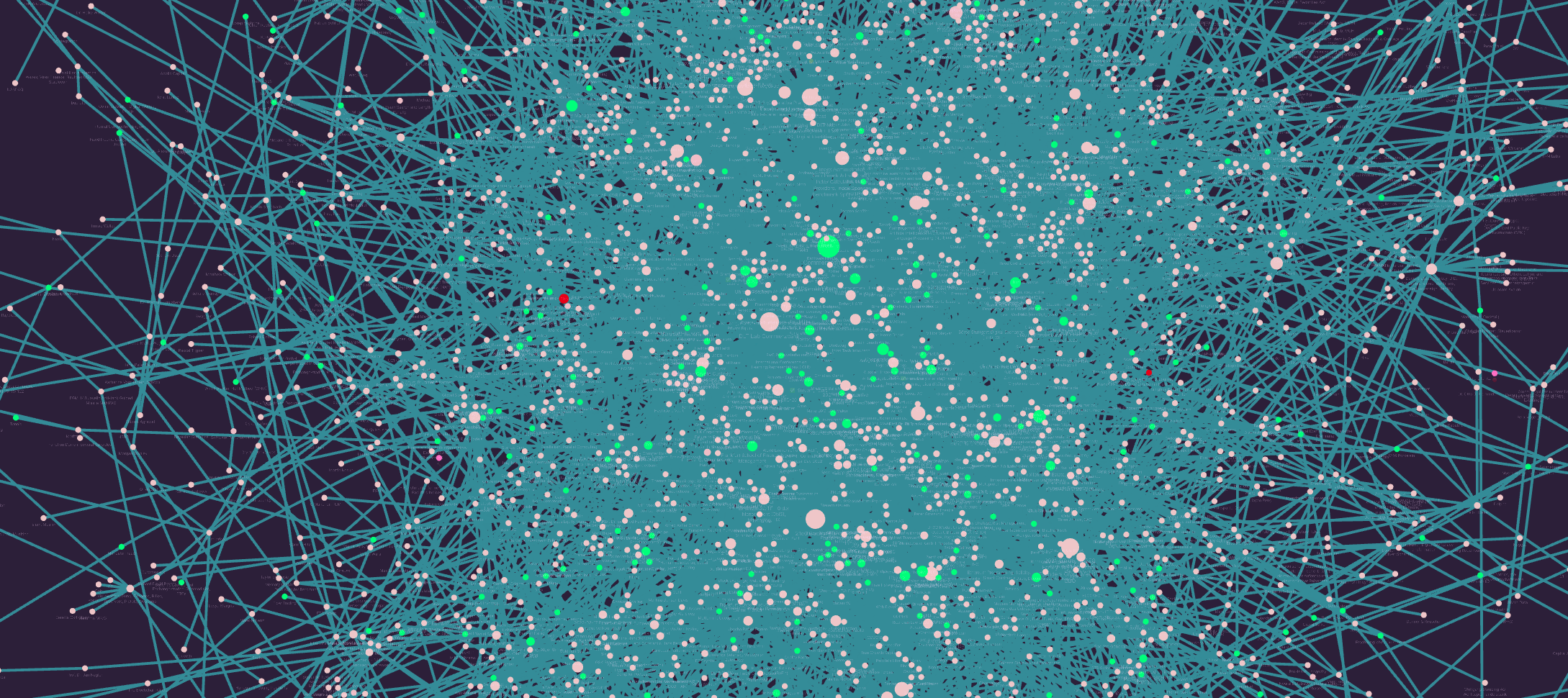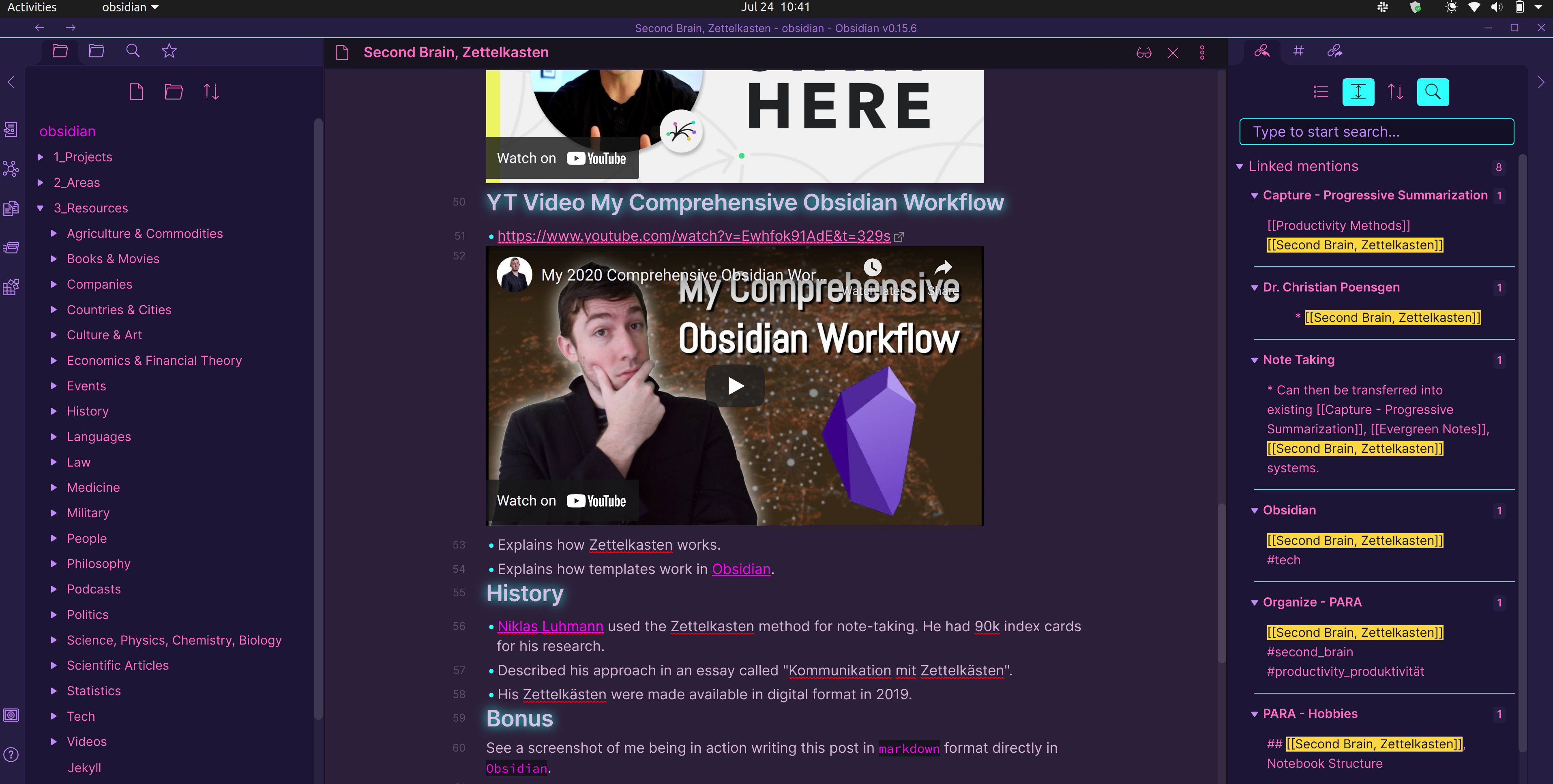Second Brain/Zettelkasten
This article is updated on an ongoing basis. Latest change: 2022-08-20. See the version history of this repository for exact versioning.
 Jan Spörer’s second brain visualized by Obsidian’s “Graph View.”
Jan Spörer’s second brain visualized by Obsidian’s “Graph View.”
Basic Idea
The second brain concept was first brought to my attention by productivity book author [[Dr. Christian Poensgen]].
The first widely-used and documented second brain was [[Niklas Luhmann]]’s “Zettelkasten.” The English name “Second Brain” has since mostly taken over.
While there are different flavors to using a second brain, the basic idea is to have interconnected atomic notes.
Another essential convention is to use [[Evergreen Notes]]. As the system organizes itself with minimal overhead and scaling costs, notes are meant to last. One does not need to delete old notes; one can revisit existing notes to add information and gradually refine low-quality notes as required.
Where Do These Strange Square Brackets Come From?
Throughout this post, you see multiple [[...]]-style annotations. Those are links to other notes. I originally wrote this post directly in my second brain (as any other post on this website) and I intentionally left the square brackets in.
Implementations
Obsidian is my recommendation. It is available on all desktop operating systems. Obsidian, however, does not have free built-in backups and versioning. I use git to version my Obsidian second brain. You can also put your Obsidian files in a Google Drive folder, in another folder synced by a cloud provider, buy Obsidian Sync, or get used to git (ask me for help).
Obsidian is a great private wiki, just that it performs quicker than any web-based wiki page. Obsidian executes fully locally and feels like a breeze. The shortcuts in Obsidian make usage more productive and intuitive.
Implementation options include:
- Obsidian -> Free, desktop-based. There is a mobile version as well, but this requires the built-in sync functionality (for vaults that are synced between desktop and mobile). Built-in sync costs money. But other automated sync options are available as well (Google Drive,
git, and many others). - Roam Research -> Paid subscription, browser-based. Check this NESSLABS guide to Roam Research.
- Athens -> Free local version. Specialized on being a wiki for startup teams. Thus emphasizes the idea of shared access. (This would also be possible using multiple
git-tracked repositories with Obsidian, each with different access permissions.) - RemNote -> Paid subscription. Ability to create flashcards. The flashcard feature is insanely good. One can create text flash cards and also image flashcards using image masking. Available on mobile devices!
- Other options:
More Advanced Concepts and Recommendations for More Advanced Structures
Do Not Over-engineer Your Second Brain
While no second brain requires a classical folder structure, it still might be useful to at least give your second brain a minimal bit of rigid structure. Links between notes will still always be the most important structuring mechanism.
So first of all: do not over-engineer this! You will probably notice that links between notes already provide 10x better structure than any note-taking approach that you have used so far, even without any additional structure.
If you do would like to get a bit more advanced, I recommend the PARA method by [[Tiago Forte]]. Check this link. PARA will, at the very minimum, require you to drag and drop each new note into one of four different folders. That’s an acceptable effort.
PARA divides your notes into 1_PROJECTS, 2_AREAS, 3_RESOURCES, and 4_ARCHIVE. Check the link mentioned in the previous paragraph, and here comes my own interpretation.
How I Use PARA
1_PROJECTS: Short-term, completable to-dos. A completable to-do would be “finish this homework.” I tend not to use this folder much as it is too much overhead compared to using physical to-do lists.
If you already have an acceptable to-do tracker (digital or analogue), I think it is not necessary to maintain this folder too strictly.
2_AREAS: Long-term, non-completable to-dos. These are areas of life that require a certain balance to be maintained. My 2_AREAS folder contains the following sub-folders and one file:
|-2_AREAS
||-21e6
||-Commerzbank
||-Education
||-Finance
||-Leisure & Private
||-Physical Health & Longevity
||-Productivity
||-Psychology, Social Interaction, Happiness, Wellbeing, Wohlbefinden
||-Spoerico GmbH
||-Work
||-Ziele, Goals (file)
As you can see, these are crucial, high-level, long-term, never-ending areas in life that require constant attention.
If you are on Windows, you might run into problems with such long file and folder names. But not with Linux, which is the OS I am using. Long, expressive folder and file names help to find notes quicker using the ‘ctrl+o’ shortcut.
Track your long-term goals here. In my second brain, this is where notes go that are very specific to myself (unlike many notes in
3_RESOURCES).
3_RESOURCES is the most significant chunk in my second brain. For each concept I find interesting, I create a note and put it there. I also manage all static real-world concepts and objects there such as Countries & Cities, and People. I have hundreds of people notes in there and thousands of notes on tech-related concepts. (There are 22 sub-folders in my 3_RESOURCES.) There is also a note called Russian Invasion Into Ukraine 2022 with embedded videos about political and military analyses.
|-3_RESOURCES
||-Agriculture & Commodities
||-Books & Movies
||-Companies
||-Countries & Cities
||-Culture & Art
||-Economics & Financial Theory
||-Events
||-History
||-Languages
||-Law
||-Medicine
||-Military
||-People
||-...
Use this folder for theories/concepts and for real-world objects (countries, companies, people). I use this folder as my knowledge base.
4_ARCHIVE is where old 1_PROJECTS go.
4_ARCHIVE: This folder is basically your trash bin. It does not require subfolders. I rarely need it, as I rarely use the1_PROJECTSfolder.
The PARA structure is simply a folder structure, see here:

Other Guides to Improving Your Notes
Another good concept: progressive summarization by [[Tiago Forte]].
Also check the NESSLABS newsletter.
- Some quotes from the Forte Labs PARA guide
- “A project has a goal to be achieved - a discrete event that will happen, allowing this item to be completely checked off and struck from the list. And this goal is supposed to take place by a specific moment in time. It has a deadline or timeframe, whether externally or self-imposed.”
- “Projects always fall into Areas.”
- “By breaking these responsibilities into bite-sized projects (as in the list on the right), you ensure that your Project List will change nearly every week. This creates a rhythm and a momentum of project completion to maintain your motivation. It generates the constant novelty that the latest research suggests is essential for satisfaction.”
- “Now, imagine the psychological effect of waking up to the list on the left day after day, week after week, month after month, even year after year. Areas of Responsibility rarely if ever change, remember? No matter how hard you work, how many years of service you put in, the list of never-changing obligations only gets heavier and longer.”
- “I couldn’t design a better method of killing personal motivation if I tried.”
A note on labels: Do not use labels. They are not necessary. If, after using a second brain for a year, you feel the need for labels, go ahead.
Resources for Beginners
Video: Obsidian for Beginners
Explains that a Zettelkasten helps to separate information capture [[Capture - Progressive Summarization]] and organization [[Organize - PARA]] from the writing process. You can write without repercussions.
Video: My Comprehensive Obsidian Workflow
https://www.youtube.com/watch?v=Ewhfok91AdE&t=329s
Video: My Comprehensive Obsidian Workflow (Long Version)
https://www.youtube.com/watch?v=wB89lJs5A3s
History of the Concept
[[Niklas Luhmann]] used the Zettelkasten method for note-taking. He had 90k index cards for his research.
Described his approach in an essay called “Kommunikation mit Zettelkästen.”
His Zettelkästen were made available in digital format in 2019.
Credits: Thanks for my colleague Leona Blehova for pointing out the origins of the Zettelkasten method.
Bonus: Me Writing This Page in Obsidian
See a screenshot of me in action writing this post in markdown format directly in Obsidian.
